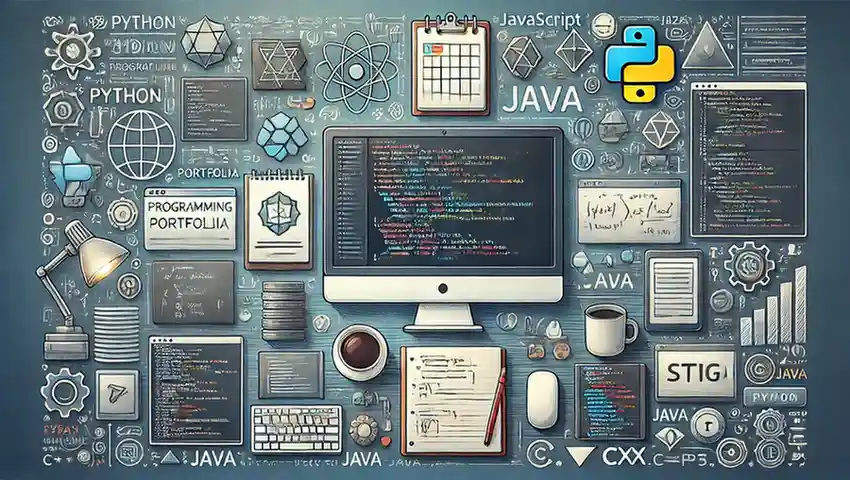Today, you need to have a programming portfolio that is well crafted and unique to stand out in the process of getting a job. You want your programming portfolio to show who you are as a developer, your problem-solving skills and leave an impact on potential employers and clients that will last. In this comprehensive guide, you’ll learn how to build an amazing programming portfolio that can help you get that dream job or gain the clients you want to create with such projects.
A Programming Portfolio Explained and Why You Need One
The number of projects that is a programming portfolio is more than an application of projects; it’s a presentation of who you are. Here’s why having a programming portfolio is essential:
- Showcase Your Skills: A programming portfolio allows the employers to see your output instead of just your resume. A list of skills is usually not as effective as this visual demonstration.
- Demonstrate Problem-Solving Abilities: Shows employers how you think and solved problems — your ‘imagine it, design it, build it’ approach — in real world projects featured in your Programming portfolio.
- Build Credibility: When you’re new to programming or changing careers, having a polished programming portfolio sets up trust and proves your experience.
- Stand Out in the Job Market: There are hundreds of resumes, but not many have programming portfolios that show you what they can actually do. Having a good programming portfolio is a sure way to separate you from the crowd Having a good programming portfolio is a sure way to separate you from the crowd.

1. Define Your Goals
Prior to actually diving into programming, give yourself a good idea about what you want your programming portfolio to accomplish. Are you working on a specific job role, like front end development, back-end development or data science You either want to attract freelance clients or you want to attract more freelance clients. The type of projects and skills you’ll show off in your programming portfolio will be based on your goals.
- If you want to become a front-end developer, spend a lot of time working on projects in your programming portfolio where you brought your proficiency in HTML, CSS, JavaScript, user interface design and UX.
- For people that are interested in the role of data science, add projects dealing with data analysis, machine learning/powering visualization tools in your programming portfolio.
Choose the Right Platform
Choose a platform with which you’re most familiar and which better suits your specialization and hosting preferences for that programming portfolio. Popular options include:
- GitHub Pages: This is perfect for showing off code, and for deploying projects. It’s free and works well with your repositories so it’s perfect for a programming portfolio.
- Personal Website: Full functionality and branding makes it possible. A professional programming portfolio is a great written website like WordPress, Jekyll or possibly custom built.
- Bedance or Dribble: Great for use during the building of UI/UX design or game development, then adding to your programming portfolio.
LinkedIn: It is not a portfolio platform in itself, but it can serve as a host for an example of your work and link to your main portfolio.
Emphasize Your Finest Work
Quantity of stuff doesn’t matter as much as the quality of it in a programming portfolio. Pick three to five pieces that you feel are your best, with a variety of skills to showcase, instead of piling your audience thick with too many tasks. Your programming portfolio should contain the following for each project: Explain what are the objectives of the project.
- Technologies Employed: Make a list of the tools, frameworks, languages that you use very clearly.
- Approach to Problem-Solving: Try to narrative the issues you faced and w relieved ways you handled them. This will be especially useful to employers looking for problem solvers.
Link to the code or demo: If you have a project on GitHub, link to it here; otherwise, if you have imported it to a site such as Code Pen, simply provide a link to that project; additionally, if you have a video tutorial that demonstrates the project Importing Bokeh to HTML, please link to that instead.
If wanted projects are beyond your area of expertise, consider including them in your programming portfolio as a mobile app to solve a specific problem, as a responsive website or e-commerce platform.
It’s a dashboard for visualizing data using Tableau or a D3 JS library.
Doing things that contribute to respectable open-source initiatives.
You can also read: Python Tips for Beginners: 10 Ways To Increase Productivity
Make a section on ‘About Me.’
To make your programming portfolio seem a little more intimate, include an ‘About Me’ section. Briefly recite your association of a professional background. Where are you on the programming path now and how have you got here?
Important abilities and passions: If there’s a particular area you love and are an expert in, highlight it.
- Career objectives and desires: Summarize what you want to do with your career.
This section makes you human, and helps recruiters or clients see your story while they review your programming portfolio.
Make It User-Friendly
Your programming portfolio should present your work in a well-organized format in order for visitors to easily kind through your work. Keep these tips in mind:
- Use a clean and responsive design: So, your programming portfolio should show beautifully on all desktop and mobile devices.
- Ensure fast loading times: To make your programming portfolio optimal prevent delays don’t optimize images and code.
- Create intuitive navigation menus: Let users easily find your programming portfolio, where your projects, contact details and your resume are located.
Putting Testimonials and Endorsements
Ask for testimonials if you’ve worked with clients or worked on a team project. Positive feedback will make your programming portfolio more impact by strength the credibility. If testimonials aren’t really an option, then think about linking to LinkedIn recommendations or even references.
You can add a Blog section (if you want).
It’s easy to add a blog to your programming portfolio and stand out.
- Tutorials or how to use guides for other technologies you’ve already mastered.
- Insights from projects you’ve worked on.
- For programming best practices or industry trend.log to your programming portfolio can set you apart. Write about topics like:
A blog proves your communication abilities and keeps your programming portfolio live.
Keep It Updated
Add new projects, skills, achievements or whatever you have added to the field of programmers to your programming portfolio regularly. An outdated portfolio can make you look outdated. It’s an easy thing to forget: After creating any content, set a reminder to go and review it and give it a refresh every few months.

Mistakes to Avoid
- Overloading with Projects: Viewers are often overwhelmed by too many projects. Have just a few pieces in your programming portfolio, but focus on them being of high quality.
- Ignoring Design: Your programming portfolio can be a distraction if it’s badly designed. Take some time to vision a nice-looking layout.
- Lack of Personalization: Program your programming portfolio for who you are going after. Less impactful than generic portfolios are.
- Omitting Contact Information: You should make it easy for viewers to reach you. Your programming portfolio can also include email address, LinkedIn profile or a contact form.
Elevate Your Programming Portfolio by Using Tools and Resources
Here are some tools to streamline the process:
- Code Editors: Work on your programming portfolio using these IDEs as VS Code, Atom or Sublime Text.
- Version Control: Manage and share your code with Git, the GitHub.
- Design Tools: You design nice looking projects in Visual programming portfolio using Figma or Sketch or Adobe XD.
- Web Hosting: Platforms like Netlify, Vergel or GitHub Page are how you can deploy your programming portfolio.
- Learning Platforms: Add new projects to your programming portfolio by staying updated with courses in Coursera, Udemy or Freedcamp.
Conclusion
A programming portfolio is your best weapon to represent your skills, your honesty, and your spirit of experimentation. This is an investment into your career and can open up doors to unimaginable possibilities you might not want to miss out on. That’s right! Through the meticulous selection of projects, a well thought out picturesque (with pinching to zoom) layout and regular updating of your portfolio, you can have a programming portfolio that truly stands out. Your programming portfolio, whether you’re looking for jobs, trying to line up freelance work, or just trying build your personal brand, can be your most impressive piece of professional ‘resume’ yet, and you should begin creating it today.
I’m also on Facebook,, Instagram, WhatsApp, LinkedIn, and Threads for more updates and conversations.
